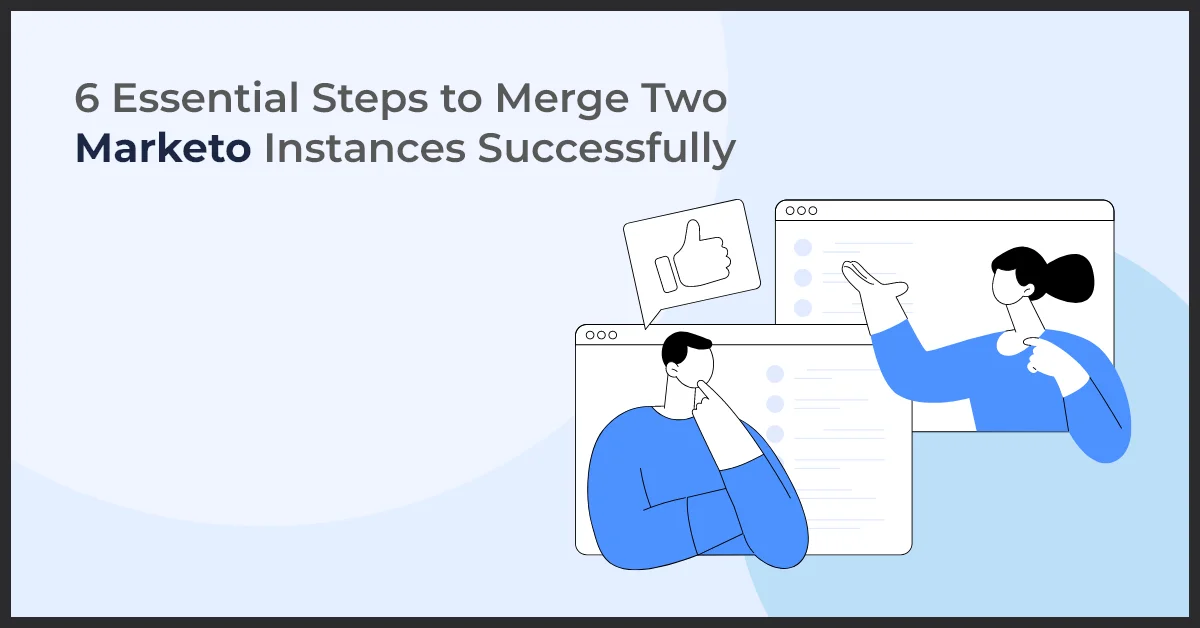6 Essential Steps to Merge Two Marketo Instances Successfully

Published on: December 21, 2022
Updated on: July 08, 2024
1571 Views
- Marketo
6 min read
The merger or acquisition of a business introduces both opportunities and challenges. It often means making big changes to your IT infrastructure.
If you are considering merging your two Marketo instances, you need to understand that it is a complex process that requires careful planning and execution to ensure data integrity and a smooth transition.
The merger of two Marketo instances represents a significant strategic move for companies, offering a spectrum of both fresh possibilities and risks that can profoundly impact your marketing and sales operations.
In this blog post, we’ll talk about the different situations in which companies consider merging their Marketo instances and the essential steps to do it right.
Let’s start. Shall we?
Different Situations in Which Companies Need to Merge Their Marketo Instances
Companies may find themselves in various situations that prompt the need to merge their Marketo instances. Here are different scenarios in which companies may consider merging their Marketo instances:
- Business Expansion and Integration: When a company acquires or merges with another business, it may have separate Marketo instances. Merging these instances streamlines marketing operations and ensures a consistent approach across the newly integrated entities.
- Regional or Divisional Alignment: Large organizations with multiple regional or divisional units may operate individual Marketo instances. Merging them centralizes marketing efforts, enabling better coordination and efficiency.
- Operational Streamlining: Companies with multiple Marketo instances for different product lines or brands may merge them to simplify marketing operations and reduce redundancy.
- Data Unification: Combining Marketo instances allows for the consolidation of customer and lead data, creating a single, comprehensive view of customer interactions and behaviors.
6 Key Steps to Ensure Seamless Merger Two Marketo Instances
Now that we’ve established why a company is considering merging its Marketo instances, let’s explore the 6 essential steps to merge your two Marketo instances seamlessly.
1. Start With a Kickoff Meeting
It is one of the most important steps before getting started with the merger process. Schedule a kick-off meeting to review your existing Marketo instance and determine how you will set up the workflows. Here are some key points that you should consider during this meeting:
- What are your business goals?
- Which data actually matters?
- Do you want to employ the parent company's domain for email communication, or do you wish to retain the existing one?
- What's the proposed working approach for the newly integrated marketing team?
- How does this merger align with the global workflow of the acquiring entity?
- Set milestones, timeframe, and the next steps in the process.
2. Perform an Audit
It's time to assess the targeted instance once the team has agreed on a general project plan. Even though it might hurt, you really don't need to keep everything. You would then be a hoarder. Simply choose the tools, data, and historical information that will aid in the decision-making of your executives. Here are certain workflows and points you can audit:
- Existing projects, future plans, and sponsored advertising.
- Project and asset analysis and classification (build, discard, let run and expire)
- Engagement initiatives
- Events, webcasts, webinars, emails, and newsletters
- Forms
- Landing pages, content that is locked
- Fast-track sales (request a demo, contact us, sign up)
- Forms and procedures internal (BDR prospecting)
- Custom objects, fields, and webhooks
3. Cleanse Your Database
Cleansing your database should be your top priority. Cleaning your database is important as it allows better segmentation of leads, prevents you from sending duplicate emails, and effectively removes bad leads to stay below the pricing threshold. When you cleanse your database, make sure to:
- Deduplicate your contacts before migration
- Decode the approach your CRM administrator plans to adopt for handling duplicate records in the future
- Assess and review disengaged leads
- Review sync rules
- Block field updates
4. Define Priorities
While merging your two Marketo instances, make sure you set your priorities as immediate, necessary, and not required. Also, identify and prioritize assets like email templates, landing pages, forms, workflows, and reports that need to be transferred to the target instance.
5. Implement Your Plan
Now that you have created your plan and have priorities in place, it’s time to implement your plan. To do this, you need to:
- Begin the process by requesting Marketo Support to establish connectivity between the two instances.
- Create new custom fields as needed and adjust field names or hide unnecessary fields based on the results of the fields audit.
- Develop new tokens and segments if required to align with the merged instance's needs.
- Implement custom objects, webhooks, and third-party integrations to ensure seamless data flow and functionality.
- Perform data migration from the source instance to the destination instance while ensuring data integrity.
- Create email templates, landing page templates, and a subscription center to maintain a consistent brand and user experience.
- Build program templates following industry best practices for more efficient campaign execution.
- Implement lead scoring mechanisms and appropriately stage new leads within the lead lifecycle.
- Prepare the database for export from the current Marketo instance, making it import-ready for the destination instance.
- Prior to the switch, export a list of hard-bounced emails for re-uploading after the synchronization.
- Note that lead activities, campaign results, and program members cannot be directly migrated. Consider exporting this data from the old instance for storage in a data warehouse for future reference.
- Ensure compliance with data regulations (e.g., GDPR, CAN-SPAM, CCPA) by reviewing and managing consent mechanisms, unsubscribe lists, unsubscribe dates, and opt-in dates.
- Prepare to import all necessary programs, keeping in mind workspaces and campaign folders for organized management.
- Keep records of successful imports and note any failures or issues encountered during the process.
6. Test and Run
To ensure everything is functioning correctly, it's crucial to conduct testing on assets, programs, lead flow, attribution, and reporting. To do this effectively, assemble a team of experts to
- Verify all tools and programs
- Review operational programs and update them if necessary
- Recreate new programs and templates for whom import failed
- Test reminders and leadership assignments
- Test reporting in Marketo, and/or a BI tool
Conclusion
By following these key steps and maintaining open communication with all involved stakeholders, you can increase the likelihood of a seamless Marketo instance merger. A well-executed merger ensures that marketing operations continue without disruptions and that data integrity and efficiency are maintained throughout the process.
Wish to Merge Your Marketo Instances Flawlessly? Let’s Talk!
If you need any help with the merger process, our Marketo wizards will be happy to assist you. Just drop us a line at info@growthnatives.com, and we’ll take it from there.



